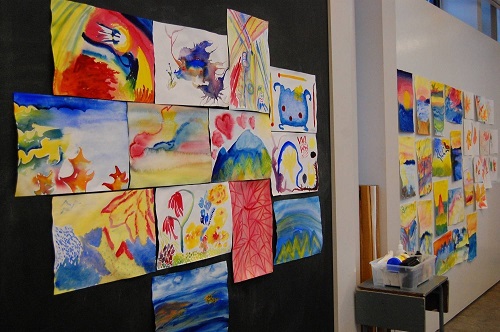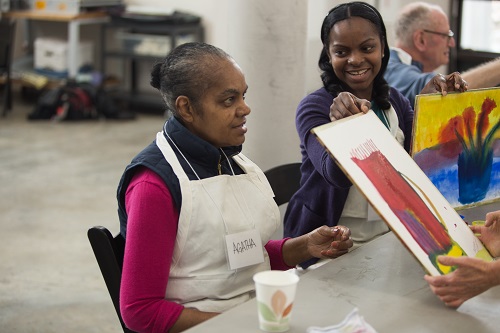Grant Spotlight | October 21, 2016
Share This |
Recipient: Frye Art Museum Program: Museums for America Year Awarded: 2014 Grant log number: MA-20-14-0283-14 Website: Video introduction of here:now: |
Contact: Jill Rullkoetter, Senior Deputy Director
|
Pictured above: A woman participates in an art-making class at the Frye Art Museum as part of the Creative Aging program, here:now, a museum-based arts engagement program in Washington State for adults living with dementia and their care partners. Since 2010, the Frye has witnessed substantial growth in the number of visitors who are living with dementia. As a response to this unique community, the Frye’s here:now program gives adults living with dementia and their care partners a creative and social outlet to enjoy conversation, works of art, and art-making classes in a supportive setting . (photo by Lou Daprile).
|
Research study: http://dem.sagepub.com/content/early/2015/04/12/1471301215577220.abstract Video introduction of the Frye’s Creative Aging Programs: https://www.youtube.com/watch?v=qu8CRK_X138&feature=youtu.be |
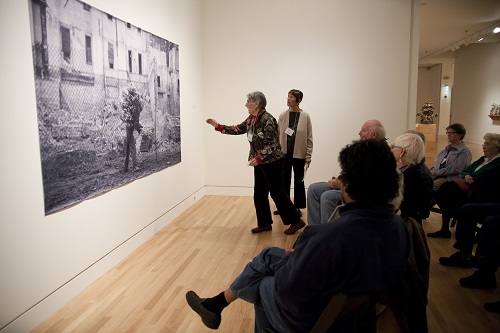
Many stories of dementia depict a narrative of hardship for both the person living with dementia and their loved ones or care partners. Often times, these stories are plagued by a sense of hopelessness or depression for both the person living with dementia and their loved ones. However, Seattle’s Frye Art Museum is painting a new story – one where museum programming promotes creative aging – a process which turns the reality of dementia into one of hope and understanding.
A novel approach to engaging an aging population
The Frye Art Museum opened its doors in 1952 with the vision and commitment to celebrate artistic inquiry and provide a rich, free visitor experience. The museum is situated in a neighborhood in Seattle where it shares its streets with three teaching hospitals and a heavy population of older adults. In 2010 the Frye began to see a dramatic increase of visitors living with Alzheimer’s disease or another dementia. As a result, the museum developed a deep commitment to creating programs that target this population and their care partners. Through this commitment, here:now, an arts engagement program for adults living with dementia or Alzheimer’s and their care partners, was born.
here:now at the Frye
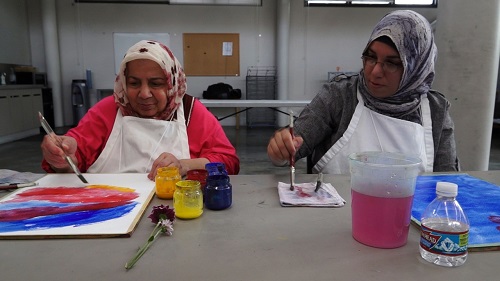
Currently, the museum offers monthly gallery tours facilitated by specially-trained museum educators and gallery guides. The discussion-based tours highlight works of art at the Frye with guided conversation creating an exchange of ideas without relying on short-term memory. The Frye also offers a six-week class that supplements gallery tours with studio art-making experiences for adults living with dementia and their care partners. The sessions encourage experimentation with various media including watercolor paint, clay, and collages.
“A goal from the beginning was to reduce the feelings of isolation and depression, which is such a challenge for people who are living with dementia,” said Mary Jane Knecht, Manager of Creative Aging Programs at the Frye Art Museum. “So often, especially in the early phases when people are aware of their developing dementia, they experience a sense of discomfort in being in a public situation. We aim to create a very safe, supportive environment where these people can be social in a public place.”
A differentiating factor for here:now is the aim to serve the care partner. “Serving the care partner as well as the person living with dementia is what has made the program so strong,” said Knecht. “The programs provide opportunities for care partners to have a respite from their responsibility as care givers, but also personal growth and strengthening of the relationship by having new experiences together.”
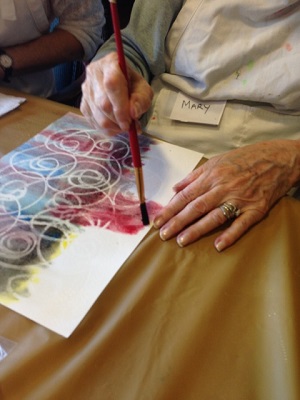
Building ‘Bridges’
As the program evolved, staff wanted to reach out to individuals who either cannot or do not want to leave their homes to visit the museum because of their illness. An off-site program, Bridges, allows the museum to reach that population by sending a teaching artist into an individual’s home or memory care facility for one-on-one creative artmaking. Three visits are scheduled with teaching artist Carmen Ficarra, who has developed a host of lesson plans that can be tailored to the individual level. At the end of the three sessions, Ficarra leaves art materials behind so that the person living with dementia and their care partner can continue on their journey of creative aging long after the sessions’ end.
During these sessions, Knecht observes the effect on participants’ level of enjoyment, sense of anxiety, apathy and depression, levels of social interaction and engagement, and their level of self-confidence. “When people live in care facilities, they have so few choices to make, which is something that these programs offer – simple choices. It’s interesting to observe if there is a level of increased confidence in the participants because they are able to make these simple choices,” said Knecht.
Closing the gap between older adults and younger supporters
Beyond improving the well-being of the person living with dementia by lowering levels of depression and anxiety, one of the project’s goals is to make a cultural shift in how the community looks at and takes on the responsibility of caring for those living with dementia. “The museum has created an environment where all of our staff extend the highest level of dignity and respect to the community we serve with these programs,” said Knecht. “I am also gratified by how many young people have been involved as volunteers or as interns with our creative aging programs. It’s great to see that there is a younger generation committing themselves to helping and caring for this community.”
Fostering “Tremendous Potential” for increasing the well-being of people living with dementia
Throughout here:now’s evolution, Dr. Lee Burnside, a geriatric medicine physician at the University of Washington’s Division of Gerontology and Geriatric Medicine and an early supporter and champion of the program, watched here:now and evaluated the program’s benefits to its participants. His research, published in the March 2015 issue of Dementia: The International Journal of Social Research and Practice, looks at the conceptual model and impact of arts programs on the dementia-effected population, concluding that programs such as the one held at the Frye hold “tremendous potential for increasing cognitive, social and creative engagement” and have the potential to improve the quality of life for this population and their care partners.
Next on the Horizon
For the Frye staff, the programs’ highlights have been far too many to recount. “Seeing the relationships that develop between participants in our classes is remarkable,” said Knecht. “It’s wonderful that over a period of time, a sense of community developed amongst the class. Success is being able to provide this community an opportunity to interact with one another.”
In 2016, the museum is poised to touch between 1,600 to 1,700 people with the creative aging program. Many throughout the state look to the Frye as a source of leadership and inspiration for creative aging and how they might implement similar programming.
In September, the Frye convened a professional development conference and workshop featuring discussions on art, creativity, and dementia care. Dementia, Art and Legacy explored the topic of legacy-making for people living with dementia and introduced creative approaches to support and encourage people with dementia to share stories with loved ones and future generations. The Frye’s published book, Creative Aging, premiered at the conference and is currently available to colleagues around the country who wish to know more about the impact of this program.1
The Frye Art Museum is constantly looking for different ways to expand their offerings, to touch as many people as possible with their creative aging programs. They feel that by engaging this population in creative lifelong learning, they are fostering a deep sense of community where people living with dementia have creative outlets for aging that are tailored to their unique needs.
1 If you are interested in receiving a hard copy of the Frye Art Museum’s book on creative aging, visit http://store.fryemuseum.org/collections/read/products/creative-aging
